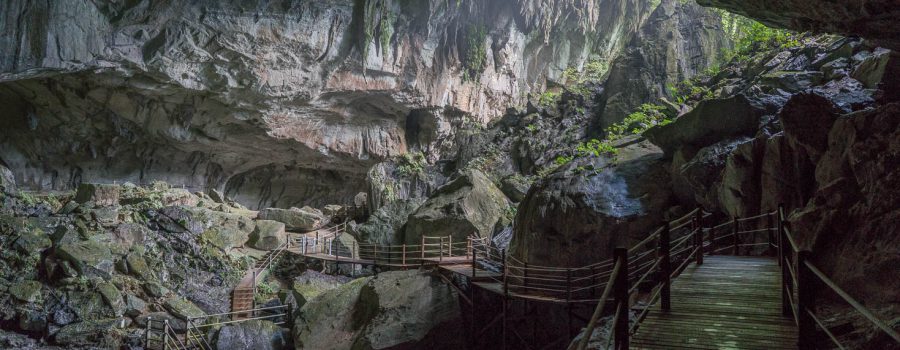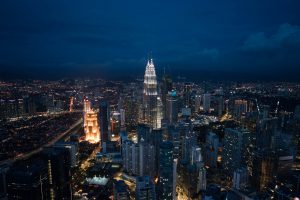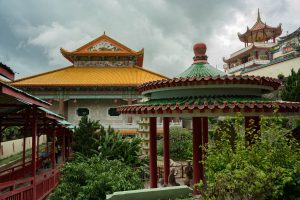While there is rainforest at many places on Borneo, the combination of gigantic caves embedded into dense tropical rainforest makes Mulu National Park one of a kind. The dimensions of the whole network of caves that are connected with each other reaches a length of 240 km. While some caves are made accessible to us tourists, many caves still remain to be discovered and cannot be accessed due to various reasons such as being underwater caves or being situated too deep inside the mountains.
During our five-day stay Ilinca and I visited four different caves, and in Clearwater Cave I participated in a guided tour off the tourist path which involved climbing, walking through water, and even swimming in small rivers about 2.5 km inside the mountain in the complete absence of any natural light source. The caves in the park are generally classified in three categories:
- Dry Caves are caves that don’t contain running water anymore. The underground rivers that formed those caves now flow through caves at lower levels. The absence of a river at the cave floor allows the growth of stalagmites and stalactites, making these caves look very beautiful. Lang Cave, Deer Cave and Wind Cave belong into this category.
- Wet Caves still contain a flow of water which continuously makes the cave grow, mostly vertically but also horizontally. Clearwater Cave belongs into this category.
- Underwater Caves are completely filled with water and are located at lower altitudes than wet caves and dry caves. These caves are the least explored ones as diving equipment is necessary to access them and the exploration also involves big risks due to the missing oxygen. Naturally, no such cave could be visited by us tourists.
Exploring Clearwater Cave
The Tourist Section of Clearwater Cave
The entrance to Clearwater Cave is very impressive. It is decorated with various plants, and lots of daylight can enter through the huge hole to illuminate the tourist section that is secured by board walks. The dimensions of Clearwater Cave are very impressive. Over some stairs tourists can reach the crystal clear river that runs through the cave.
Going off the tourist path
Apart from the caves that contain a solid board walk, Mulu National Park also arranges guided adventure caving tours. I participated in one of those tours called Clearwater Revival that started where the tourist section ended in Clearwater Cave. At the end of the boardwalk where the cave started to get dark, we stepped down to the river and started going deeper and deeper inside the mountain. After only a few meters, the daylight from the cave’s entrance was gone and we were completely in the dark, the only source of light were our headlamps.
During the next 1.5 hours, we entered almost two more kilometers into the cave along the river. We were walking on sharp limestone rocks, on slippery mud, sometimes also inside the river. On the way out we could also swim some parts in the river which was especially exciting. Whenever we had to climb over some big rocks along the riverbed or cross the river, fixed ropes were in place, so it was not as difficult as it may sound. At the deepest point in the cave, our guide told us to turn off our lamps. And there we were… 2.5 km inside the mountain, and it was completely dark, we only could hear a few bats and the river flowing through the cave. This was a very impressive moment. Thoughts went through my head, what if I went in here alone and my lamp’s battery died? I would never make it out alive… It was nice to turn on the lamps after one minute again and see the beautiful rainforest when exiting the cave after more than 3 hours in the dark.





Fauna inside a cave
It is hard to imagine that any animals live in such unfriendly conditions, however, we saw several species: bats, crabs, fish, bugs, crickets and giant spiders, some of them with a diameter of around 25 cm. They all adapted to the absence of light.
Wind Cave
Being a dry cave, wind cave was beautifully decorated with stalactites and stalagmites. Its name however it got due to the fact that in the narrowest part of the cave, there is usually a slight breeze because the cave is open in the middle as the rock collapsed there and hence wind is blowing towards the entrance from there.







Lang Cave
Named after the guy who discovered it, Lang Cave is also a dry cave with nice decorations. It was the least spectacular cave I have visited, but as it is neighboring Deer Cave, it was worth a visit as well.
Deer Cave
The last dry cave we visited at Mulu National Park was deer cave. Unlike the name suggests, the cave is not inhabited by deer anymore as they have been hunted down by the local tribes a long time ago.
However, deer cave is home to millions of bats. They all live at the ceiling of the enormous cave during the day, and then in the evening usually all of them fly out to feed from tons of flying insects in the nearby forest. This creates a huge spectacle for visitors that are seated in front of the cave when a black swarm of bats flies out of the cave. However, bats are picky with the weather and they only fly out if it is not raining. This is not mainly because they do not want to get wet, but rather because their ultrasound navigation does not work well in heavy rain.
We were unlucky this day because there was actually rain until shortly before sunset so the bats decided not to fly out (yet). Most likely they have flown out later, but because it was dark already, it was not possible to see them anymore. Nevertheless, Deer Cave was absolutely fascinating as the diameter of the cave was the largest I have ever seen (and the second largest in the world) and we still could witness the presence of the bats because most of the cave floor was covered by huge pile of bat excrements.




















